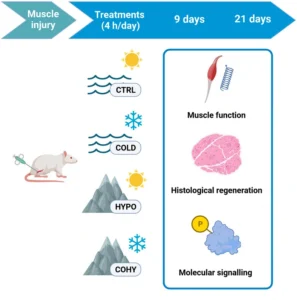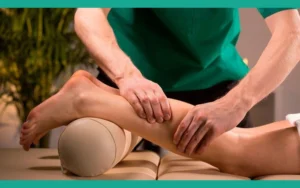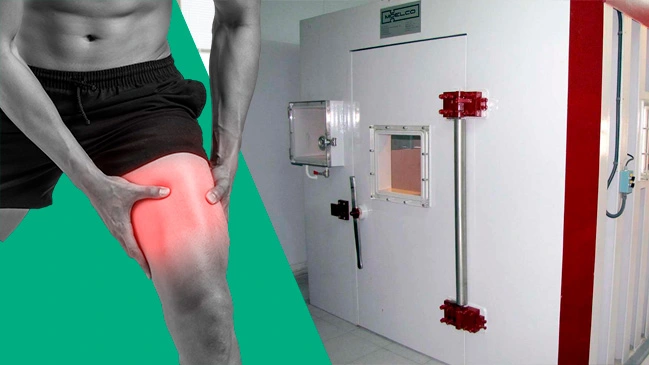Muscle injuries are a common problem among the active population, leading to a significant number of absences in both the sports and work sectors. Due to its high plasticity, skeletal muscle can respond to various stimuli to maintain and enhance functionality.
These injuries can be complicated, requiring long recovery periods that include rehabilitation, medication, and even surgery. A recent study from the University of Barcelona has proposed a new strategy that could revolutionize how these injuries are treated, offering faster and more effective recovery.
This study, published in the Journal of Physiology, provides scientific evidence on the benefits of intermittent exposure to low oxygen concentrations (hypoxia) in low barometric pressure chambers (hypobaric), which simulate high-altitude conditions. This method, already used to improve physical conditioning in high-performance sports, is now revealed as a promising option to accelerate muscle regeneration after an injury. (1)
How Does Hypoxia Accelerate Muscle Recovery? (1)
In hypobaric hypoxia conditions, the body experiences a reduction in the amount of available oxygen, triggering a specific physiological response. In particular, the HIF pathway (hypoxia-inducible factor) is activated, a protein that acts as a sensor of oxygen levels in cells. This activation stimulates a series of processes, such as the proliferation of capillaries and the enhancement of oxidative metabolism, which facilitate muscle regeneration.
The study, led by experts such as Garoa Santocildes, Teresa Pagès, Joan Ramon Torrella, and Ginés Viscor, suggests that this approach is not only beneficial for elite athletes but also for any active person suffering from a muscle injury. Additionally, it could have applications in treating pathophysiological conditions like sarcopenia, a disease characterized by the loss of muscle mass.
Scientific Study (2)
The effects of intermittent hypobaric hypoxia (IHH) and cold exposure, separately and simultaneously, on muscle regeneration were studied. Adult male rats were surgically injured in one gastrocnemius and randomly assigned to the following groups:
1) CTRL: passive recovery.
2) COLD: intermittently exposed to cold (4°C).
3) HYPO: subjected to IHH (4500 m).
4) COHY: simultaneously exposed to intermittent cold and hypoxia.

The animals underwent these interventions for 4 hours/day for 9 or 21 days. The COLD and COHY rats showed faster muscle regeneration than the CTRL group, evidenced after 9 days at the histological level (dMHC-positive and reduction of centrally nucleated fibers) and functionally after 21 days. The HYPO rats showed complete injury recovery (histologically and functionally) after 9 days, while COLD and COHY took longer to induce full functional recovery.
A Paradigm Shift in Muscle Injury Treatment
The treatment of muscle injuries has evolved significantly in recent years. The old RICE therapy (rest, ice, compression, and elevation) has given way to more comprehensive approaches such as PEACE (protection, elevation, avoid NSAIDs, compression, education) and LOVE (load management, optimism, vascularization, exercise). In this new paradigm, hypobaric hypoxia is not only compatible but could also enhance the effects of these new therapies.

The study also suggests the possibility of combining hypoxia exposure with individualized physical exercise programs, further optimizing muscle recovery. This could be especially useful in cases of muscle atrophy or in the rehabilitation of patients with long COVID, where the combination of hypoxia and exercise could offer additional benefits.

This innovative approach to muscle injury recovery represents a significant advancement in the fields of health and sports. Intermittent exposure to hypobaric hypoxia could change the way these injuries are treated, speeding up recovery and improving the quality of life for both athletes and the active population in general. As research continues, it is likely that we will see an increase in the application of this technique in medical treatments and rehabilitation programs worldwide.
Sources:
(1) https://web.ub.edu/es/web/actualitat/w/nueva-estrategia-regeneracion-lesion-musculo?tn=np
(2) https://physoc.onlinelibrary.wiley.com/doi/10.1113/JP285398


I do not even know how I ended up here but I thought this post was great I do not know who you are but certainly youre going to a famous blogger if you are not already Cheers
Fantastic beat I would like to apprentice while you amend your web site how could i subscribe for a blog site The account helped me a acceptable deal I had been a little bit acquainted of this your broadcast offered bright clear concept
Somebody essentially lend a hand to make significantly posts I might state That is the very first time I frequented your web page and up to now I surprised with the research you made to create this particular put up amazing Excellent job
you are truly a just right webmaster The site loading speed is incredible It kind of feels that youre doing any distinctive trick In addition The contents are masterwork you have done a great activity in this matter
My brother recommended I might like this web site He was totally right This post actually made my day You cannt imagine just how much time I had spent for this information Thanks
Hi my family member I want to say that this post is awesome nice written and come with approximately all significant infos I would like to peer extra posts like this
Its like you read my mind You appear to know a lot about this like you wrote the book in it or something I think that you could do with some pics to drive the message home a little bit but instead of that this is fantastic blog An excellent read I will certainly be back
“Remarkable piece of content! 👏 Your expert analysis and clear communication make complex concepts easy to grasp. This is definitely going in my bookmarks.”
Its like you read my mind You appear to know a lot about this like you wrote the book in it or something I think that you could do with some pics to drive the message home a little bit but instead of that this is fantastic blog An excellent read I will certainly be back
Your blog is a testament to your dedication to your craft. Your commitment to excellence is evident in every aspect of your writing. Thank you for being such a positive influence in the online community.